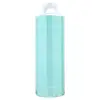What's inside
What's inside
 Key Ingredients
Key Ingredients

 Benefits
Benefits

 Concerns
Concerns

 Ingredients Side-by-side
Ingredients Side-by-side

Water
Skin ConditioningButylene Glycol
Humectant1,2-Hexanediol
Skin ConditioningPolyglyceryl-10 Laurate
Skin ConditioningPolyglyceryl-4 Laurate
EmulsifyingEthylhexylglycerin
Skin ConditioningDisodium EDTA
Caprylyl/Capryl Glucoside
CleansingBrassica Oleracea Capitata Leaf Extract
Skin ConditioningBambusa Vulgaris Extract
Skin ConditioningCamellia Sinensis Leaf Extract
AntimicrobialMentha Piperita Leaf Extract
Skin ConditioningSalvia Officinalis Leaf Extract
CleansingCamellia Japonica Flower Extract
EmollientOpuntia Ficus-Indica Stem Extract
Skin ConditioningPersea Gratissima Fruit Extract
EmollientSodium Citrate
BufferingCitric Acid
BufferingGluconolactone
Skin ConditioningPanthenol
Skin ConditioningSodium Hyaluronate
HumectantLavandula Angustifolia Oil
MaskingWater, Butylene Glycol, 1,2-Hexanediol, Polyglyceryl-10 Laurate, Polyglyceryl-4 Laurate, Ethylhexylglycerin, Disodium EDTA, Caprylyl/Capryl Glucoside, Brassica Oleracea Capitata Leaf Extract, Bambusa Vulgaris Extract, Camellia Sinensis Leaf Extract, Mentha Piperita Leaf Extract, Salvia Officinalis Leaf Extract, Camellia Japonica Flower Extract, Opuntia Ficus-Indica Stem Extract, Persea Gratissima Fruit Extract, Sodium Citrate, Citric Acid, Gluconolactone, Panthenol, Sodium Hyaluronate, Lavandula Angustifolia Oil
Water
Skin ConditioningBetaine
HumectantGlycerin
HumectantPropanediol
SolventOryza Sativa Extract
AbsorbentPhyllostachys Pubescens Shoot Bark Extract
Skin ConditioningAspergillus Ferment
Skin ConditioningPanax Ginseng Root Extract
EmollientCyclodextrin
AbsorbentScutellaria Baicalensis Root Extract
AstringentHyaluronic Acid
HumectantBeta-Glucan
Skin ConditioningCellulose Gum
Emulsion StabilisingXanthan Gum
EmulsifyingButylene Glycol
HumectantUsnea Barbata Extract
Zanthoxylum Piperitum Fruit Extract
Skin ConditioningPulsatilla Koreana Extract
Skin ConditioningSodium Phytate
Tamarindus Indica Seed Gum
Emulsion StabilisingPolyglyceryl-10 Laurate
Skin ConditioningPolyglyceryl-10 Myristate
Skin ConditioningGlucose
Humectant1,2-Hexanediol
Skin ConditioningAlcohol
AntimicrobialLavandula Angustifolia Oil
MaskingLimonene
PerfumingLinalool
PerfumingWater, Betaine, Glycerin, Propanediol, Oryza Sativa Extract, Phyllostachys Pubescens Shoot Bark Extract, Aspergillus Ferment, Panax Ginseng Root Extract, Cyclodextrin, Scutellaria Baicalensis Root Extract, Hyaluronic Acid, Beta-Glucan, Cellulose Gum, Xanthan Gum, Butylene Glycol, Usnea Barbata Extract, Zanthoxylum Piperitum Fruit Extract, Pulsatilla Koreana Extract, Sodium Phytate, Tamarindus Indica Seed Gum, Polyglyceryl-10 Laurate, Polyglyceryl-10 Myristate, Glucose, 1,2-Hexanediol, Alcohol, Lavandula Angustifolia Oil, Limonene, Linalool
 Reviews
Reviews

Ingredients Explained
These ingredients are found in both products.
Ingredients higher up in an ingredient list are typically present in a larger amount.
1,2-Hexanediol is a synthetic liquid and another multi-functional powerhouse.
It is a:
- Humectant, drawing moisture into the skin
- Emollient, helping to soften skin
- Solvent, dispersing and stabilizing formulas
- Preservative booster, enhancing the antimicrobial activity of other preservatives
Butylene Glycol (or BG) is used within cosmetic products for a few different reasons:
Overall, Butylene Glycol is a safe and well-rounded ingredient that works well with other ingredients.
Though this ingredient works well with most skin types, some people with sensitive skin may experience a reaction such as allergic rashes, closed comedones, or itchiness.
Learn more about Butylene GlycolLavandula Angustifolia Oil is more commonly known as lavender essential oil. It is considered a fragrancing ingredient.
Lavender imparts a famous scent. While the smell is lovely, this ingredient and may sensitize skin in topical products. This is because about 85% of the oil is made up of linalool and linalyl acetate.
When exposed to air, these two compounds become strong allergens. This ingredient exhibits cytotoxicity at low concentrations; amounts of 0.25% have been shown to damage skin cells.
A study from Japan found this ingredient caused lavender sensitivity after widespread exposure.
Lavender essential oil has some antimicrobial, antibacterial, and anti-inflammatory properties. However, the cons of this ingredient may outweight the pros.
More research is needed to confirm lavender essential oil's effects when used in aromatherapy.
Lavandula Angustifolia is known as the English Lavender and famous for creating purple fields in Provence, France.
Learn more about Lavandula Angustifolia OilPolyglyceryl-10 Laurate is an ester of lauric acid and Polyglycerin-10.
Polyglyceryl-10 Laurate is a cleansing agent and emulsifier. It helps gather dirt, oil, and other pollutants to be rinsed away. As an emulsifier, it helps prevent ingredients from separating, such as oil and water.
Polyglyceryl-10 Laurate may not be fungal acne safe.
Learn more about Polyglyceryl-10 LaurateWater. It's the most common cosmetic ingredient of all. You'll usually see it at the top of ingredient lists, meaning that it makes up the largest part of the product.
So why is it so popular? Water most often acts as a solvent - this means that it helps dissolve other ingredients into the formulation.
You'll also recognize water as that liquid we all need to stay alive. If you see this, drink a glass of water. Stay hydrated!
Learn more about Water